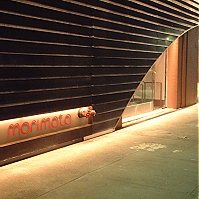Morimoto
This restaurant is closed!

Contact Info:
Address: 88 10th Ave
City: New York, NY
Zip: 10011
map: View the Map
Phone: (212) 989-8883
Website: http://www.morimotorestaurant.com/
Food Info:
Menu: View the Menu
Cuisine:
Japanese
2nd Cuisine:
Sushi
Cititour Review:
I thought it might be fitting to begin this review of Morimoto with a quote from its owner, the Philadelphia restaurateur, Stephen Starr. “Morimoto is going to be far more interesting than any restaurant New York has seen,” Mr. Starr told Florence Fabricant, in an article that ran in the New York Times on January 25th. First of all, making this sort of magnanimous declaration is just asking for trouble. Secondly, if Starr actually thinks Morimoto is more interesting than any restaurant New York has seen, clearly Mr. Starr has either (a) never eaten in New York City, or (b) is suffering from a rare and little known ailment I call Chronic Culinary Delusion (hereinafter, “CCD”), and needs a major dose of restaurant therapy. My prescription for a CCD cure would be visits to several restaurants that are far more interesting than Morimoto: WD-50, 71 Clinton (while it’s still with us), Annisa, Fatty Crab, Momofuku, Gilt, Tia Pol, and yes, how about Nobu? After my meal at Morimoto, Mr. Starr, I respectfully submit that you will need to start eating your words. Designed by Tadao Ando, the Pritzker Prize winning architect, Morimoto cost $12 million to build. That would be one million dollars for each of its precious, bright white and concrete 12,000 square feet. Um, are you kidding me? Where are people getting the money to shovel into these places? And how exactly do they plan on making it back? Now, to be sure, Morimoto is impressive. You enter through a cherry red noren, a sort of cloak that smocks the silver-shingled façade. It's a cool touch, but it feels a bit like Christos’ Gates. The initial effect of the size and ceremony of the space is compelling, but that soon evaporates, and you realize the place is actually sort of cold and sterile, and kind of ugly. The room feels like it was transported from a suburb, like a fancy PF Chang’s fed a steady diet of white paint, concrete, clear Lucite, and Ty Nant glass water bottles. Hey, if you are going to design a restaurant for $12 million, I might chose a material other than Ty Nant water bottles, which by the way, the restaurant is given for free, but charges guests $8 a pop. The Ty Nant water bottles are stacked into a sheet of glass that does the room a major disservice, slicing it down the center and precluding the all-important see and be seen factor. I don’t know about you all, but when I go out to eat (which is every day, and sometimes twice a day), I like to look around and see other people. I like to feel the energy of the room, and this wall of water just cuts into the room, dividing and conquering. In terms of the menu, I found the main theme to be way to much glitz, showmanship, and over-the-top, heavy handed presentation and not enough substance: flavors were muddy and flat, seasoning was off, and meats were overcooked. Was no one paying attention? An example of the kitchen’s inattention to detail is the crispy rock shrimp tempura ($16), served with a pair of spicy dipping sauces, one sort of like a spicy ketchup and the other more like the one Nobu serves, a creamy wasabi mayo. This dish was as good as something from Houston’s. It tasted as though it had been sitting under heat lamps for a few hours. The shrimp were chewy and the batter was thin and soggy. The Morimoto sashimi ($28), a signature, was nice actually, though it was ice cold, like it had been prepped and left in a walk-in and just removed and served. For $28, it should be prepared a la minute. But I loved the idea of it: seared toro, smoked salmon, barbecued eel, tuna and hamachi layered in a sort of raw fish Napoleon. But the dipping sauces—five of them—were presented in slim plastic test tube-things that made little fart-like noises when you squeezed them. Not pretty. People stared. I told them it wasn’t me. And do we need five dipping sauces? I think three would be enough, and please, lose the farting test tubes. Less is more. The toro tartare ($28) was absolutely ridiculous. It arrives in a massive clay tub filled with ice. Shoved into the ice you’ll find five tongue depressors (utensils), a rectangular wooden washboard smoothed with a thin layer of mushy minced toro, and a second washboard layered with stripes of condiments: wasabi, seaweed sauce, avocado, crème fraiche, crumbled bits of rice cracker, and a little bowl of dashi soy. You are to take a tongue depressor, scrape off some toro, and then scrape off a condiment of your choice, then dip it into the dashi. Not only is it is difficult to eat, but the toro was minced way too fine, so the flavor of the fish seemed to be mashed out of it. I felt sorry for the toro. What a beautiful tuna belly, totally mutilated. I thought it was senseless. Why make us work so hard to enjoy our food? Another disappointment was the kakuni ($16)—a dish that was billed as ten-hour braised pork. It is served on a puddle of bland congee—well, in its defense, congee is usually bland— soaking in a soy scallion sauce that did little to relieve the congee of its pale flavor. What’s more, that pork was braised for about ten minutes, not ten hours. We could not even tear it apart. Servers didn’t seem to notice our troubles. Share plates were not offered, nor were knives. The picture of the four of us sawing away at that pig shoulder with clear Lucite chopsticks (these chopsticks were ridiculous, they were too slippery) must have been quite hilarious. Soon, we just gave up and ordered more sake. At this point in the meal, we were starting to get depressed. We hoped our main courses would redeem the contender. Sadly, they did not. The angry chicken ($26) was not as bad as the pork. At least it was cooked well—the meat was nice and moist. But the skin was painted red with spices that were not particularly aromatic or spicy, and the chicken was plated in huge pieces over high piles of whole grilled finger peppers in a puddle of spiced chicken jus that had no finesse, no balance. The whole thing was a mess. The Waygu beef hot pot ($33) was also lacking balance and or finesse. The soy mirin broth that the flaps of beef were cooked in was cloyingly sweet—again no balance— and it bobbed with huge chunks of carrots and onions. It tasted like somehow my Mom’s old-fashioned pot roast had gotten into Morimoto’s kitchen. (Mom, is there something you want to tell me?) The braised black cod with Japanese ratatouille ($23) was passable, but not as good as the black cod with miso at Nobu. Though the flavors of that ratatouille were great, and the dressing of soy and ginger a fresh addition, the fish itself was more slimy than silky. Oh, but wait. We had sushi too. It is an afterthought in this review as it is clearly an afterthought at the restaurant. I have had better sushi on my couch, ordered in from Haru on Park Avenue South. The maki were just fine, red snapper was lovely, but our fluke sushi was ribboned with sinew and tough. And then we threw in the towel. As you can tell, we were not impressed with Morimoto. The space feels cold and vaguely like a space station, and after a while of staring at that wall of water, it is blinding. You need shades. The music was awful—zombie trance raves didn’t work for me. The service, which was quite enthusiastic, and very friendly and not the least bit pretentious at the host desk (I loved that), was also inattentive. We had to ask for share plates, we filled our own sake glasses every time (the house sake is excellent), and had to request silverware. At these prices, I don’t want to ask for anything other than the check—which I asked for as soon as I could. It was time to leave one of the most interesting restaurants New York has ever seen. If only.
Review By: Andrea Strong


